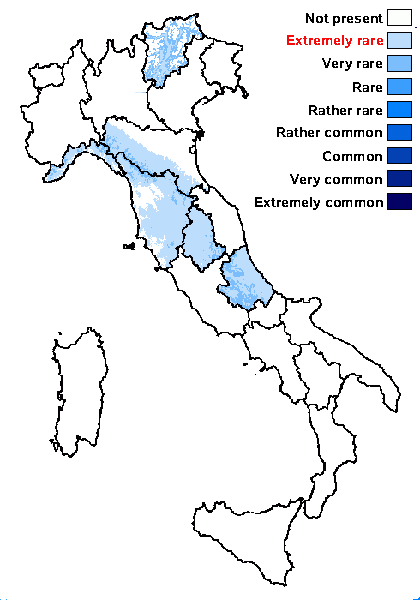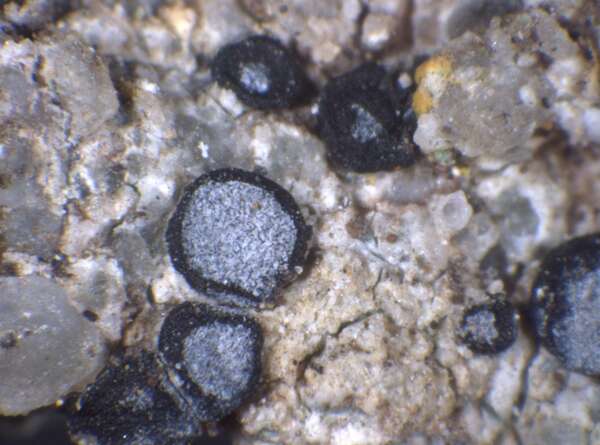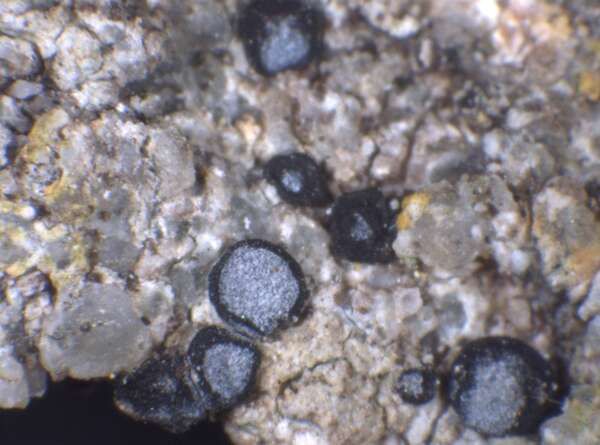Sarcogyne fallax H. Magn.
Rabenh. Krypt.-Flora, 9, 5, 1: 98, 1936.
Synonyms:
Distribution: N - TAA (Nascimbene & al. 2021), Emil (Fariselli & al. 2020), Lig (TSB 33457). C - Tosc (Tretiach & Nimis 1994, Benesperi 2011), Umb (Genovesi & al. 2001, Ravera & al. 2006), Abr (Nimis & Tretiach 1999).
Description: Thallus crustose, endosubstratic, greyish white, mostly inapparent. Apothecia lecideine, 0.7-1 mm across, slightly immersed to subsessile, with a dark brown to black (brown-red when moist), but densely white- to bluish-pruinose, flat to slightly convex disc, and a thin, soon excluded proper margin. Proper exciple 100-150 μm wide, of radiating hyphae with swollen and dark brown tips, the rim dark brown, the inner part pale brown to colourless; epithecium brown; hymenium colourless, 120-150 µm high, the hymenial gel hemiamyloid, K/I+ light blue fading to light red; paraphyses coherent, simple to sparingly branched, regularly septate, 1-1.5 μm thick at mid-level, the apical cells 2-3 μm wide, with dark-pigmented gel caps; hypothecium colourless. Asci >100-spored, cylindrical-clavate, strongly thickened at apex, the apical dome K/I-, the outer coat K/I+ blue. Ascospores 1-celled, hyaline, globose and 3-4 µm wide or broadly ellipsoid and 3-5.5 x 3-4 µm. Photobiont chlorococcoid. Spot tests: thallus K-, C-, KC-, P-, UV-. Chemistry: without lichen substances.Note: a mainly mild-temperate lichen found on steeply inclined to rain-sheltered surfaces of base-rich siliceous rocks, more rarely on calcareous rocks, which is worthy of further study. The records by Valcuvia (2000, 2002b) from Lombardy and Piedmont need confirmation.
Growth form: Crustose
Substrata: rocks
Photobiont: green algae other than Trentepohlia
Reproductive strategy: mainly sexual
In underhangs rarely wetted by rain
Poorly known taxon in need of further study
Commonnes-rarity: (info)
Alpine belt: absent
Subalpine belt: absent
Oromediterranean belt: absent
Montane belt: very rare
Submediterranean belt: extremely rare
Padanian area: absent
Humid submediterranean belt: extremely rare
Humid mediterranean belt: absent
Dry mediterranean belt: absent

Predictive model
Herbarium samples
Growth form: Crustose
Substrata: rocks
Photobiont: green algae other than Trentepohlia
Reproductive strategy: mainly sexual
In underhangs rarely wetted by rain
Poorly known taxon in need of further study
Commonnes-rarity: (info)
Alpine belt: absent
Subalpine belt: absent
Oromediterranean belt: absent
Montane belt: very rare
Submediterranean belt: extremely rare
Padanian area: absent
Humid submediterranean belt: extremely rare
Humid mediterranean belt: absent
Dry mediterranean belt: absent

Predictive model
| Herbarium samples |
 INDEX FUNGORUM
INDEX FUNGORUM
 GBIF
GBIF
 DOLICHENS
DOLICHENS




